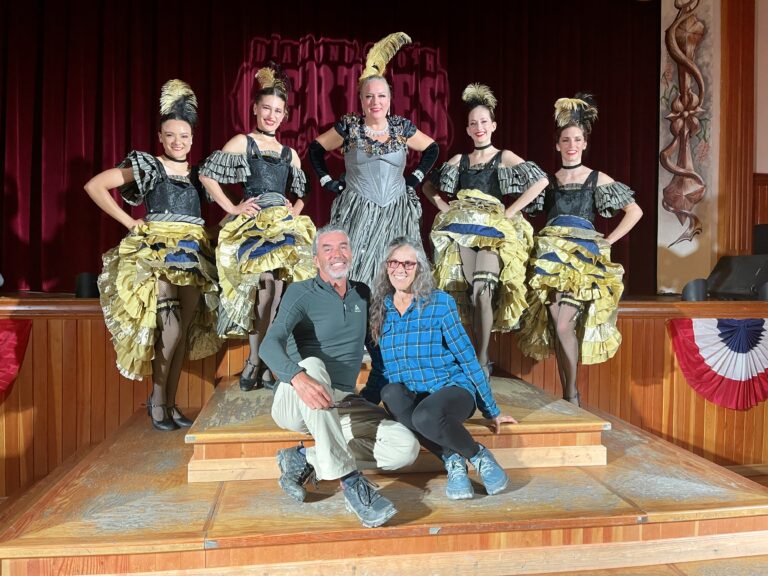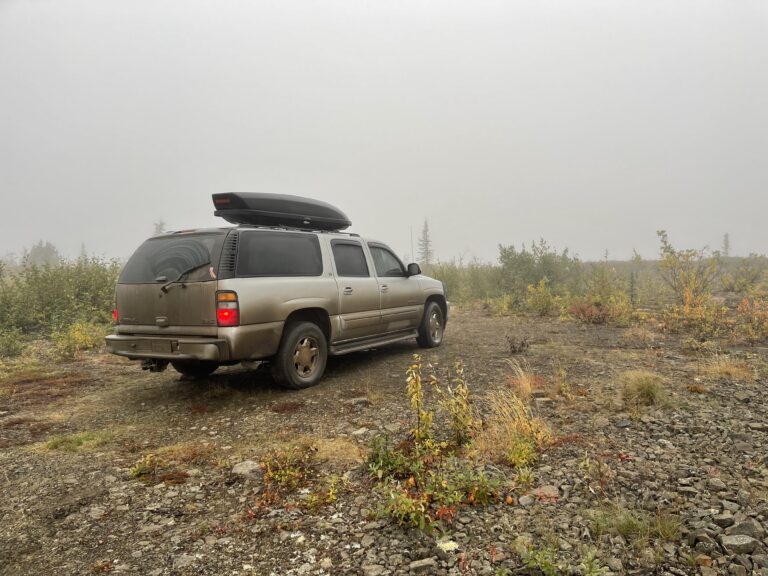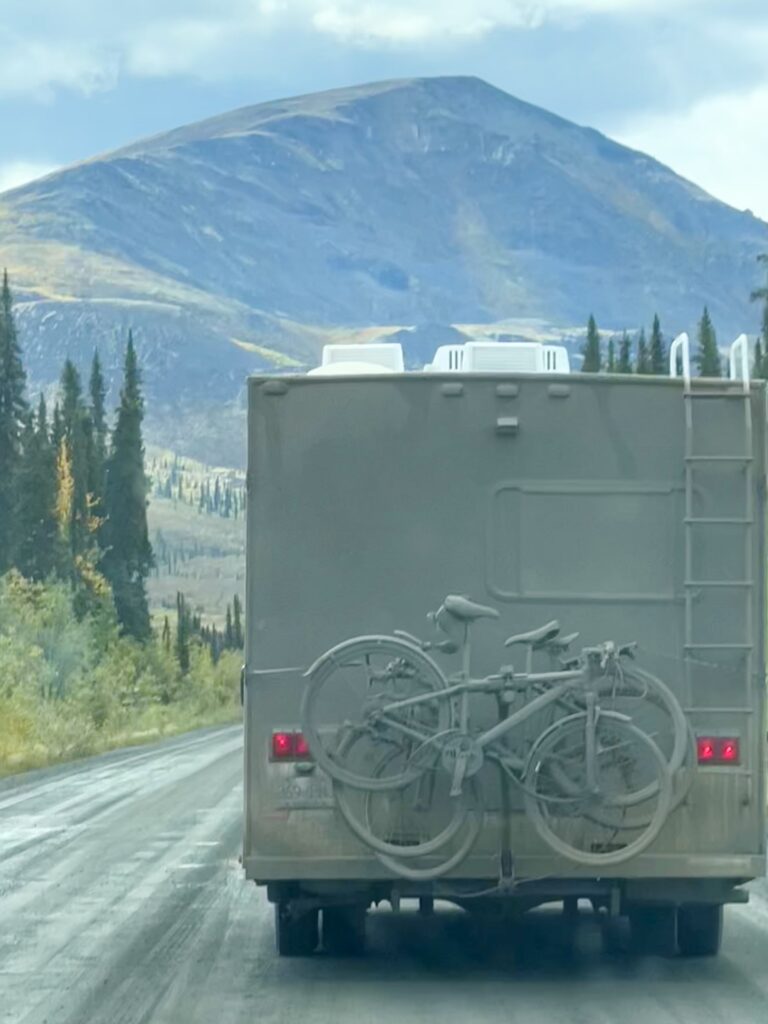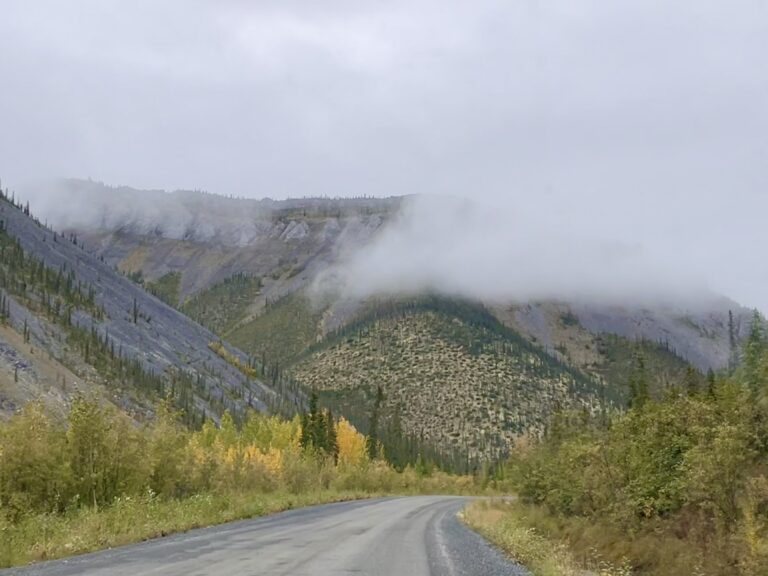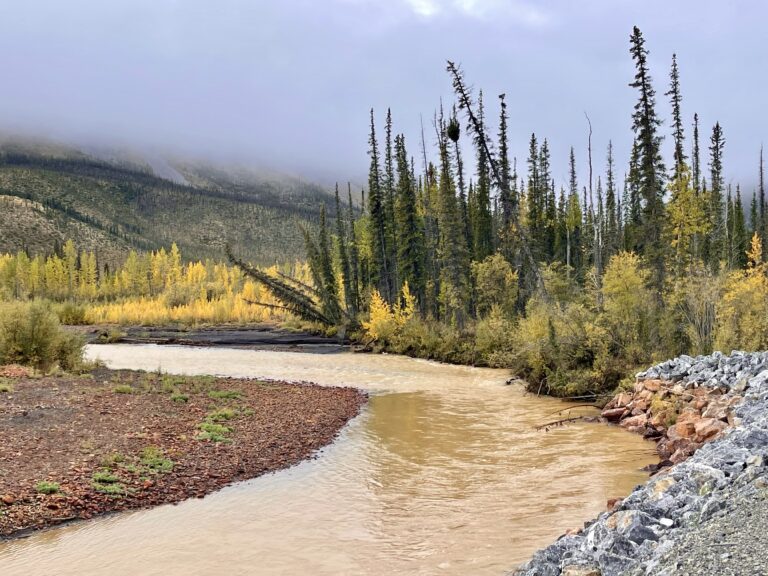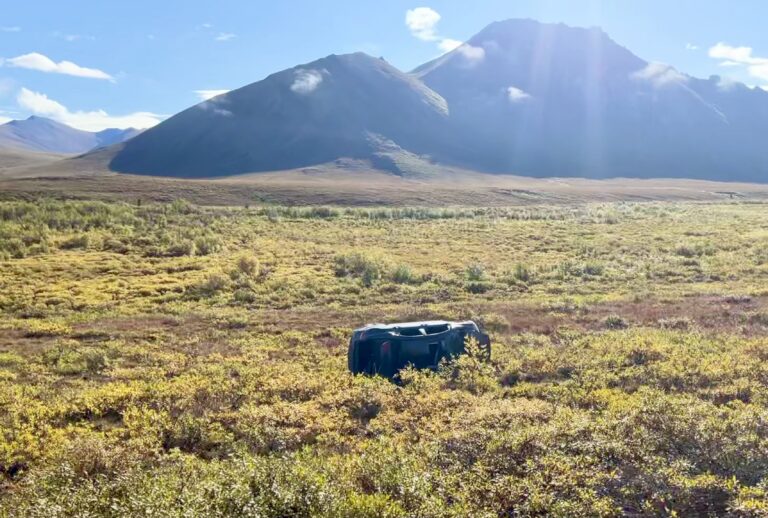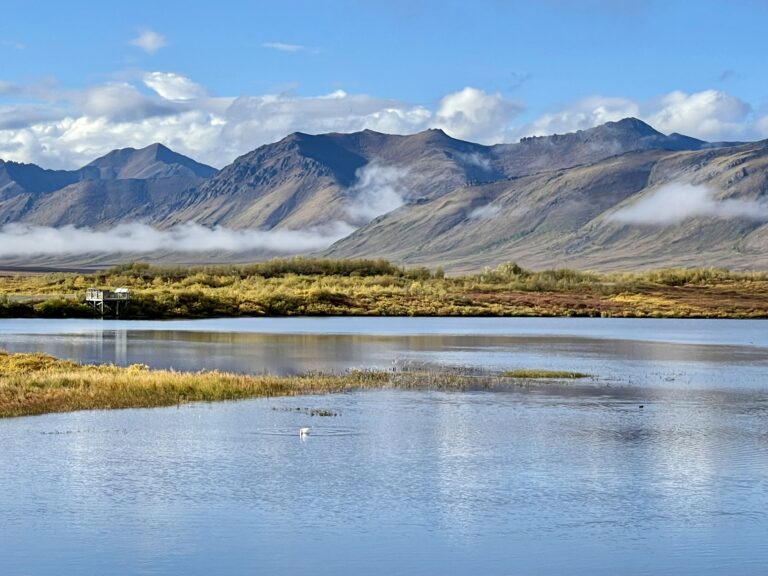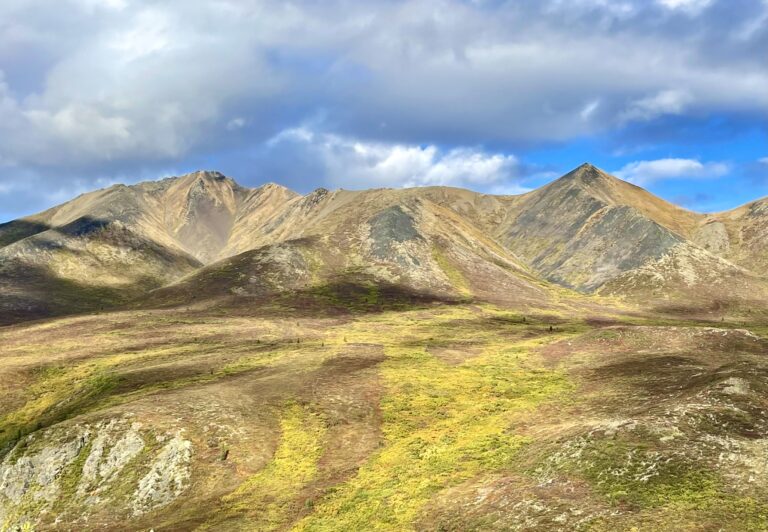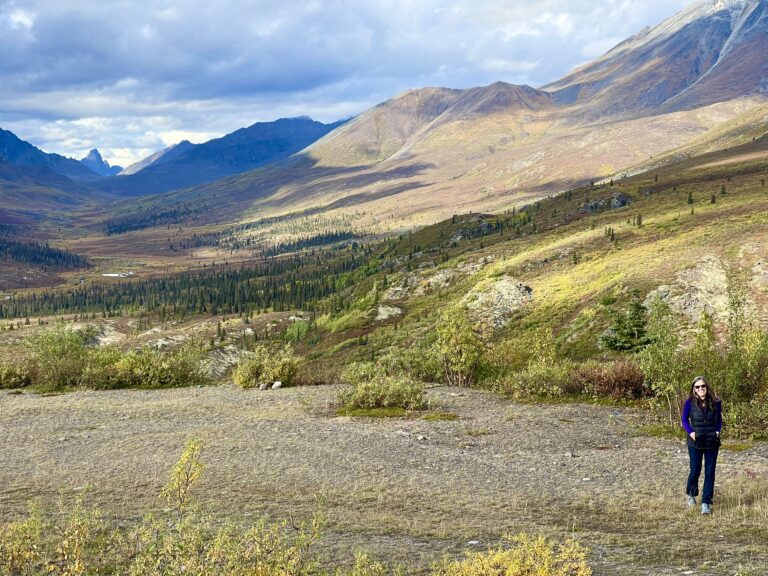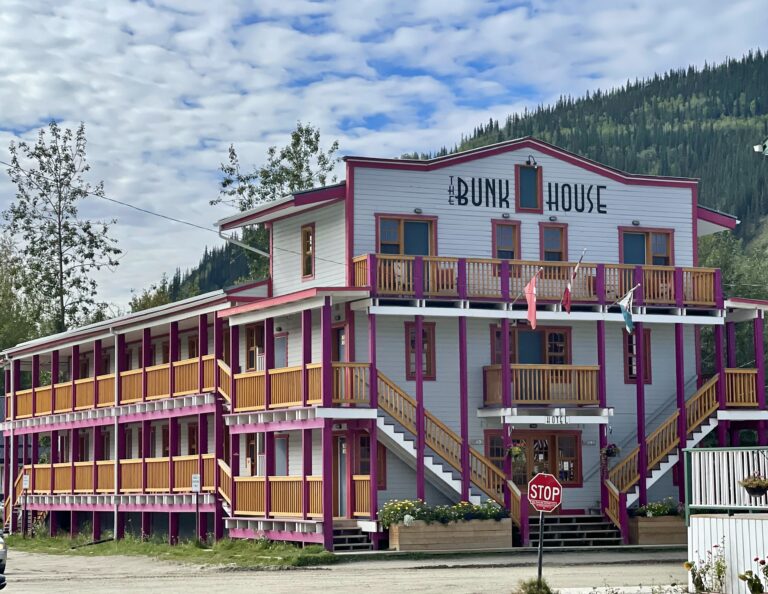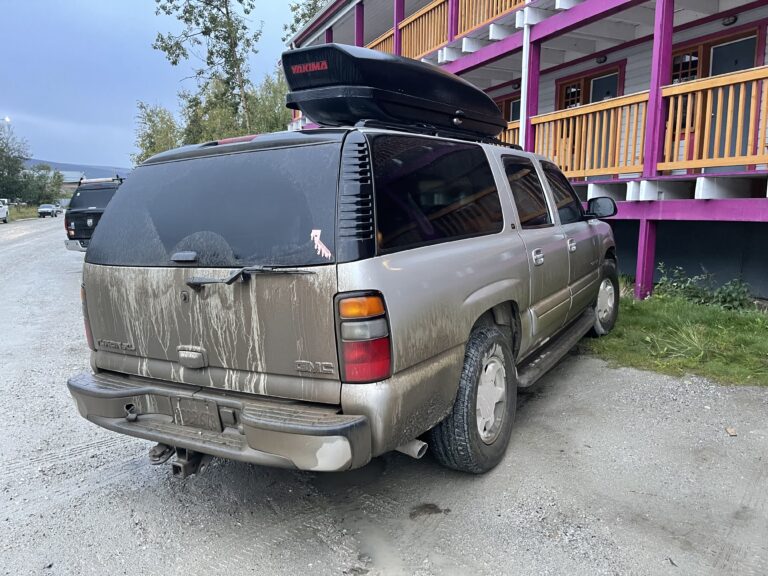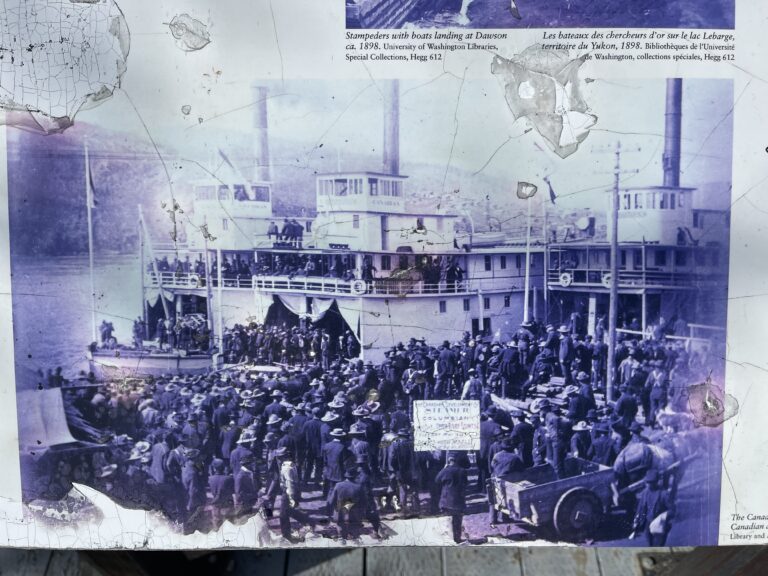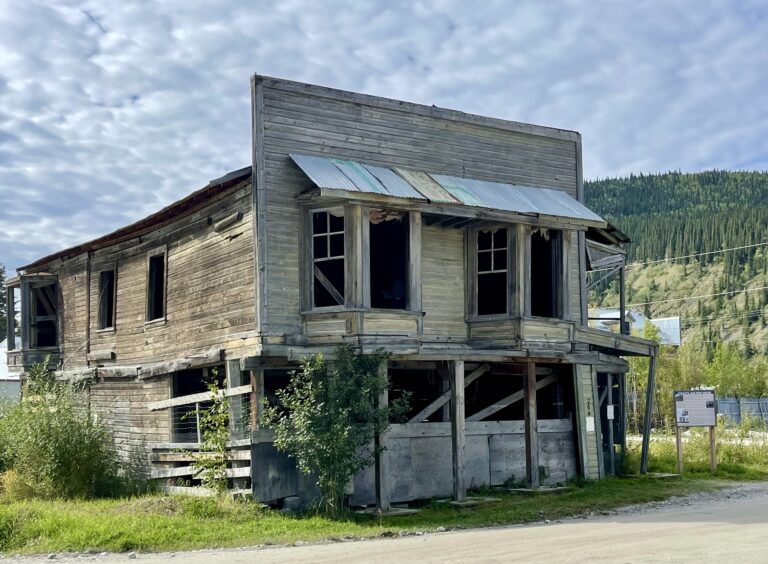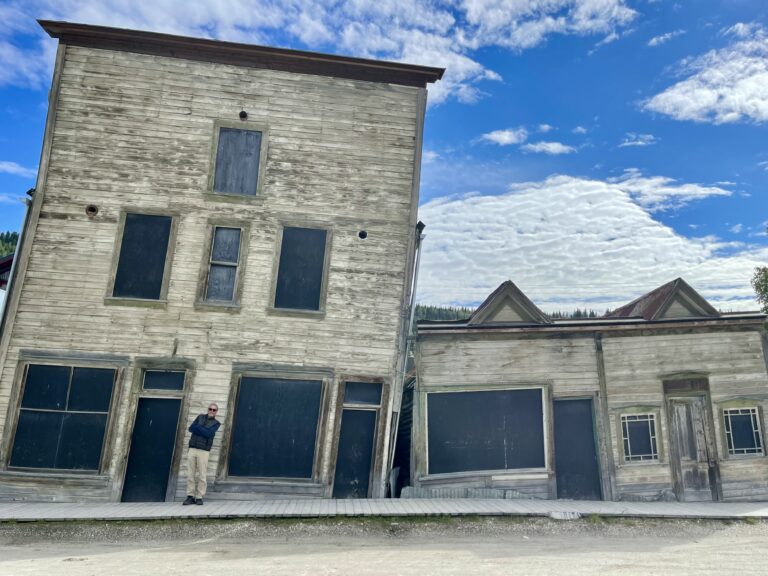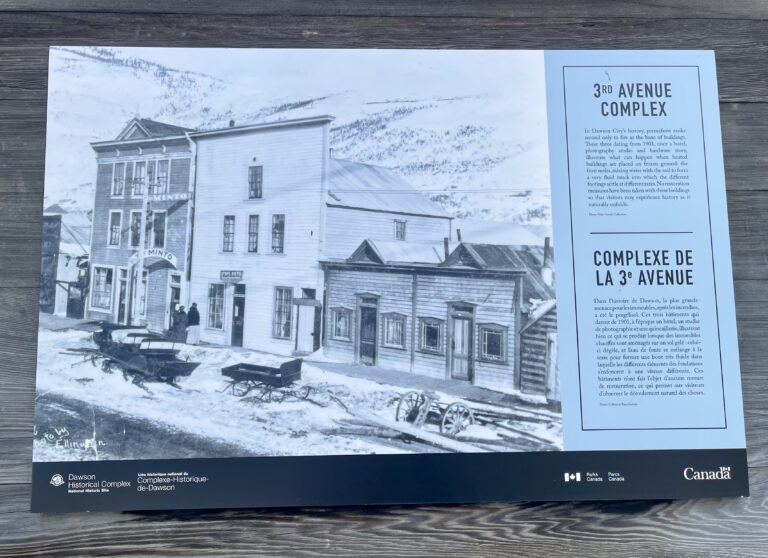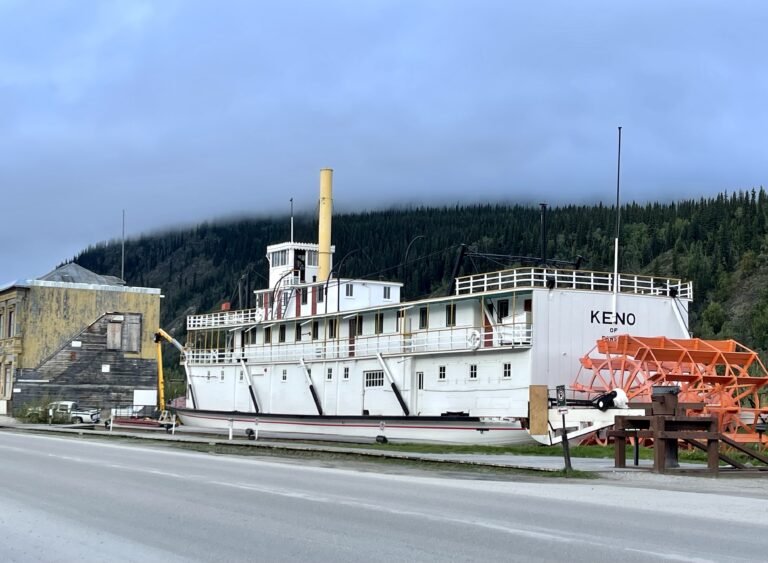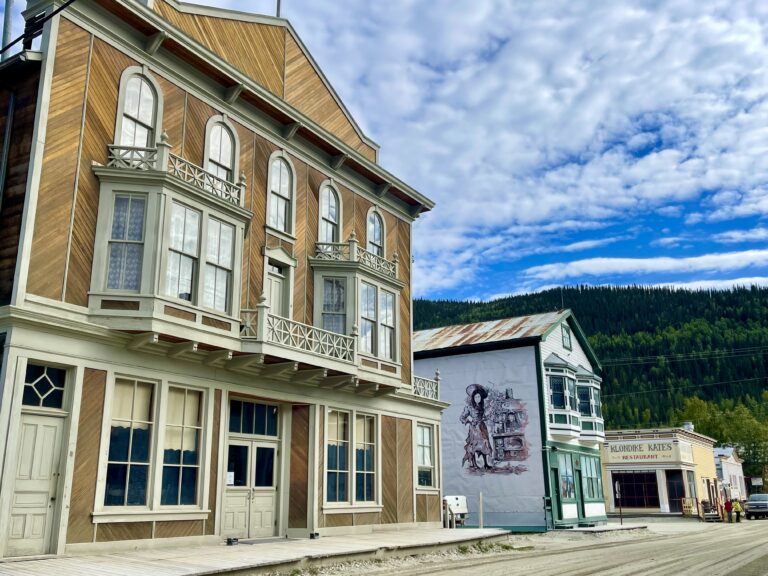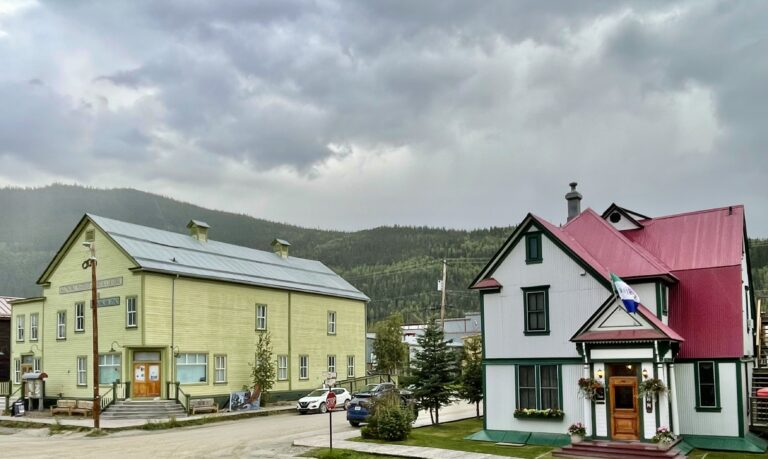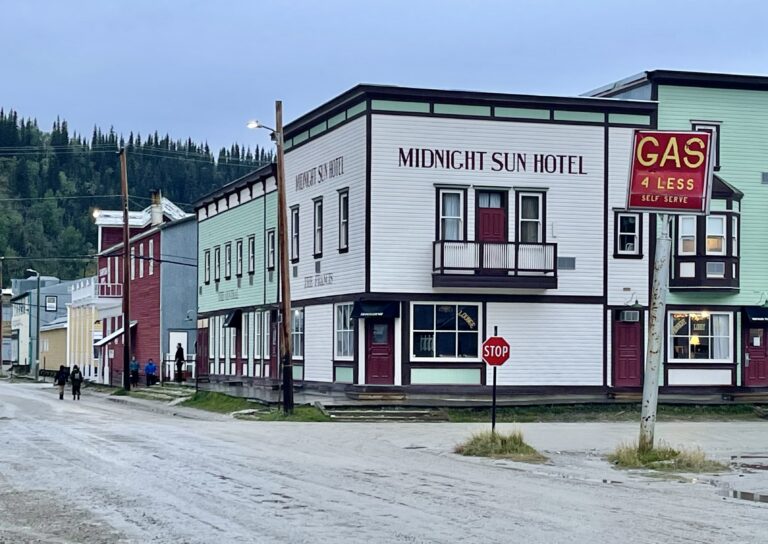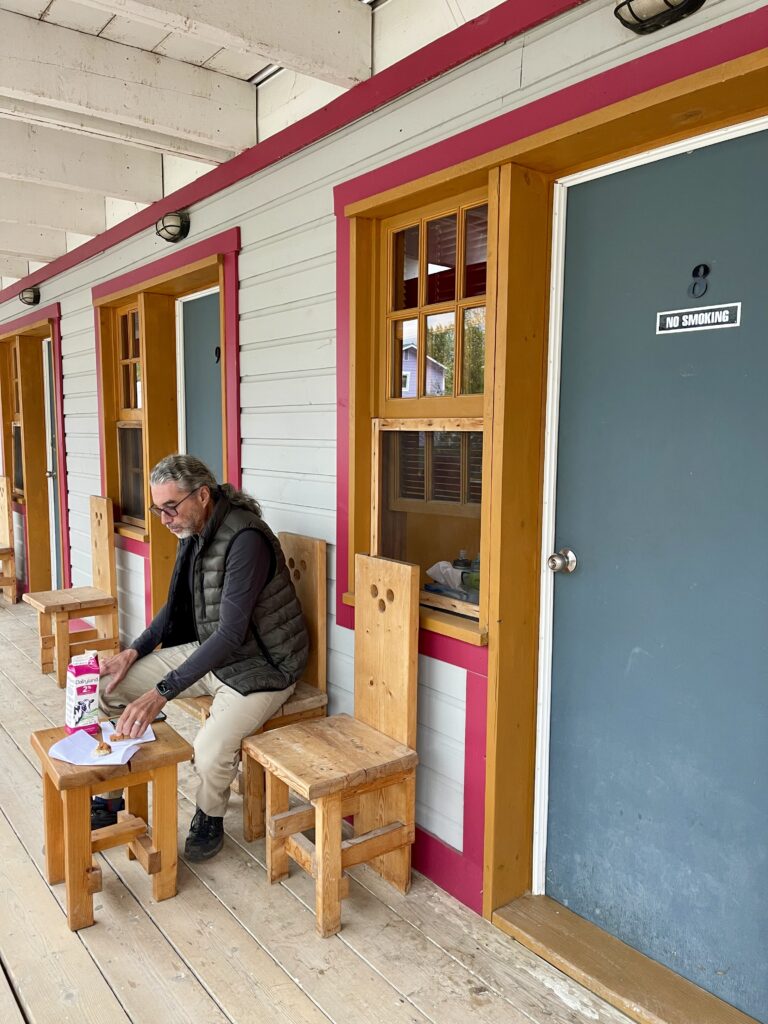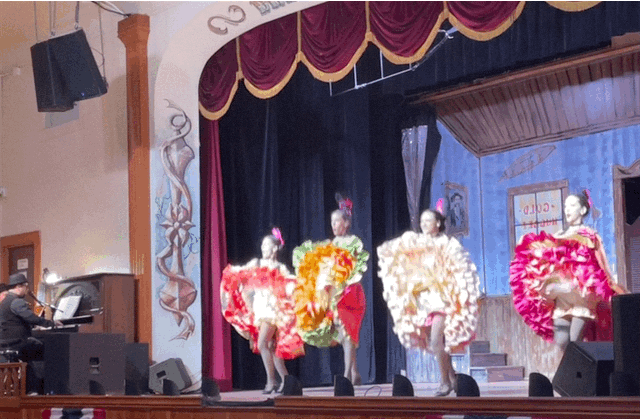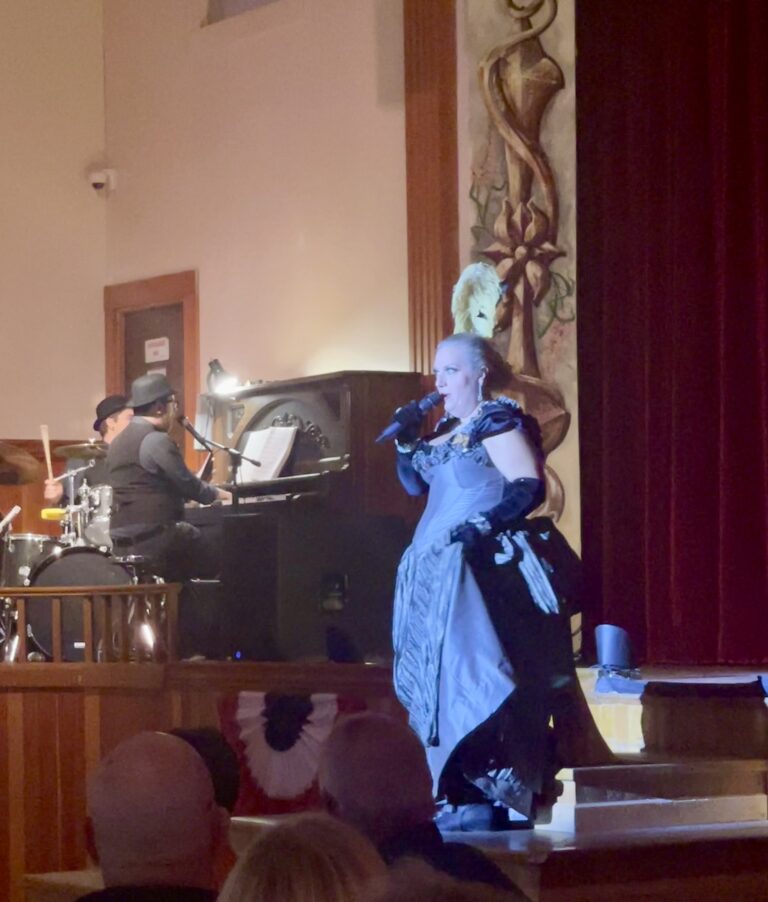August 29, 2022
It was barely 40 degrees, windy and foggy when we woke up in the truck. We still had over 250 miles of dirt road to get back to the starting point of the Dempster, and we decided to get started pretty much as soon as we were up.
Not only were the roads worse on this southern half of the Dempster, now we had to contend with driving in the fog and light rain. At least we weren’t worried about traffic because we knew there would be almost none. But if we had to drive at 35 mph the whole way it would be a really long slog.
Eventually, we got under the clouds and visibility improved. The dirt road was bad in stretches, forcing us to drive slowly with staccato potholes, loose rocks and washboard. Then it would improve and lull us into thinking we could drive 50 mph. During one of those 50 mph lulls, we came to a bridge over a creek and, too late, I saw a giant pothole just at the entrance to the concrete bridge. I hit it with a thundering crash with the left wheels, knocking our phones off their magnetic mounts and tossing the gear in back up a foot. I cursed. We were well over a hundred miles from the nearest shop. I was certain we must have blown at least one tire and maybe even bent or broke a rim. I checked tire pressures on the dash computer and all were where they were supposed to be. The steering worked and there was no wobble. Somehow our Michelin tires had absorbed the blow without shredding. I couldn’t believe nothing was damaged but pressures held.
There was a new rattle though. The truck has several and wears them proudly like scars: There’s the fast rattle from behind the radio that began after a particularly bad dirt road in Baja; there’s the slow rattle under the dash from the 25-mile-long washboard road in Utah; there’s a squeak from a few days before after the Top of The World Highway. But this one was deeper and lower and sounded heavier somewhere near the center console. I’d check it out when we got back home but it might just be a permanent character scar, like the others.
At one point we passed a newer Mercedes SUV that was broken down on the side of the road, traffic cones next to it signifying they’d already been rescued. Both of the driver’s side low-profile street tires were blown out—perhaps, I thought, from the same bridge pothole several miles back. A wholly unsuitable tire (and perhaps vehicle) for the Dempster.
One part of the road was as smooth as asphalt where the clay mud had been compressed. Sadly, it didn’t last. Driving like this was hard on us both. I had to concentrate to avoid the worst of the potholes and Susan had to continually brace herself against the bumps and avoidance maneuvers. We were definitely getting tired of dirt roads.
Eventually, we re-entered Tombstone Provincial Park where the terrain became hillier and the views amazing. The clouds had lifted and there were occasional patches of sun. We stopped a few times for stretch breaks and to explore the scenery.
Once we’d passed Tombstone Park though, traffic increased a little. Locals from Dawson City and tourists driving only the first hundred miles or so of the Dempster came to Tombstone to hike and take in the phenomenal beauty.
A few hours later, driving in the zone, it suddenly became quiet and I realized we were driving on asphalt. I recalled that the first few miles of the Dempster were paved and suddenly it was over. At the only real intersection we’d seen in hundreds of miles, we turned west toward Dawson City, 20 miles away, hoping to get a room and shower. It was located 20 miles away in the “wrong” direction, but we followed the Susanism, nothing is out of the way if there is no way.
Once we had a cell signal, our first since we left the Dawson City area four or five days before, Susan searched for rooms but most places were full or well over US$200. We ended up getting a double bed in a small 11×10 room at a place called (appropriately) The Bunkhouse. It had co-ed bathrooms down the outside walkway and while it was pretty rustic, but compared to camping it was high living.
We parked out front, stepped out of the truck, and took a good look at it. The truck was caked with thick dirt. The license plate was no longer visible. While driving, I’d noticed the tail lights had been muted and I could barely see out the back window. Even the rear-view mirrors were mud-splattered. The color of the layers of dust and mud when dry almost matched the color of the truck, which we dubbed Dempster Beige. Rocky would need a good wash at some point, but for now we were the ones who’d finally get clean.
After glorious hot showers, we walked the town we’d not had time to fully explore when we were here a week before. Signs described the town’s emergence as the center of the Klondike Gold Rush between 1896-1898 when Dawson City, located at the confluence of the Klondike and Yukon Rivers, grew from a small nearby First Nation fishing camp to a thriving town of about 30,000-40,000 almost overnight. The population plummeted to less than half that number a few years later when the gold rush ended quickly after a few major players staked nearly all the claims. The population is now about 1,500. The historic town included numerous abandoned and dilapidated buildings, including some that could barely stand up straight. A sign explained that buildings erected on permafrost settle unevenly when the frozen ground melts from the heat of the building, resulting in unstable muck around the footings.
The SS Keno was the last of the Yukon’s sternwheeler steamers to navigate the Yukon River under her own power. She’s now kept on a dry dock in town as a testament and memorial to the hundreds of sternwheelers that provided transport service on the Yukon River during the late 19th and early 20th centuries.
Most of the currently occupied buildings were restored wooden structures with metal roofs that survived the harsh conditions with grace. It was a rough and tumble place and its “wild west” roots are still very evident. All roads in the town are dirt with wooden sidewalks.
Dawson City’s economy is still based on gold mining, but also tourism. Yet it’s not a particularly tourist-friendly town. The hotels are expensive, there are few restaurants and only a couple of small stores that sell food. We both love going into stores the locals use to see what’s being sold and for how much, and we wandered into several stores, checking out local crafts, gold jewelry, and other goods. Dawson City was an expensive place during the gold rush and it’s still expensive. None of this was surprising, given the town’s remote and usually frigid location—average January temperatures there range from -2° to -17°, with a record low of -73 °F. But on this late August day, temperatures were in the upper 50’s and it was reasonably pleasant out as we wandered about.
Around 6:00 pm, we headed over to a nearby restaurant for an underwhelming and expensive meal. Bellies not quite full, we also stopped off at a tiny grocery store and picked up some overpriced, mediocre pastries for dessert.
Later in the evening a storm came in, blowing dust off the dirt streets and we retreated to our tiny room to watch the streets turn to mud as the rain came.
We were glad to have a dry, warm-ish place to be, though it felt a little odd to be indoors after living in the truck en route to and from the Arctic Ocean. The only furniture in the small, stark room was the bed, one small nightstand and a tiny desk and chair. So, we rested on the bed and listened to the rain.
We’d heard about a burlesque show a couple of blocks away and decided to brave the wind and now-spitting rain to check it out. Thirty dollars later we were at Diamond Tooth Gertie’s Gambling Hall watching four chorus girls dressed in period cancan costumes dancing on stage probably in a similar way to what the dancers did back during the gold rush days. A large woman named Gertie sang her heart out …”it ain’t the meat it’s the motion” while a piano player and a drummer in bowler hats accompanied the show. We had a drink served in a very small glass made smaller by the thickness of the glass, and it tasted like it had almost no alcohol. Also, likely period-correct.
Trudging back through the muddy streets to our shoe-box-sized room, we were glad we came back to Dawson City even if it was a 40-mile round-trip out of the way. Unlike towns like Tombstone, Arizona that were about as kitschy as you could get, Dawson City was authentic and felt genuine with roots visible back to the Klondike era. The sky was still light when we returned to our room around 11:00 pm. We drew the curtains and hoped for a good night’s sleep.

